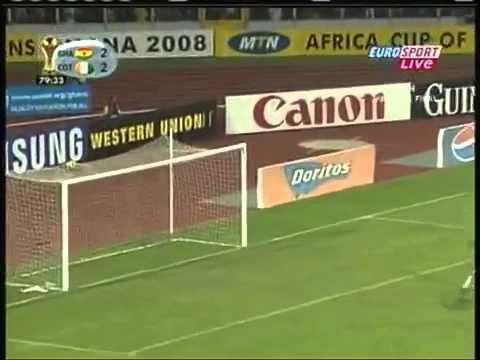Dates 20 Jan 2008 – 10 Feb 2008 Best player Hosni Ibrahim | Venue(s) 4 (in 4 host cities) Matches played 32 Top scorer Samuel Eto'o Teams 16 | |
 | ||
Similar 2006 Africa Cup of Nations, 2010 Africa Cup of Nations, 2004 African Cup of N, 2002 African Cup of N, 2012 Africa Cup of Nations | ||
2008 africa cup of nations
The 2008 Africa Cup of Nations, also known as the MTN Africa Cup of Nations due to the competition's sponsorship by MTN, was the 26th edition of the Africa Cup of Nations, the biennial football tournament for nations affiliated to the Confederation of African Football (CAF). The tournament was staged at four venues around Ghana between 20 January and 10 February 2008. Egypt won the tournament, beating Cameroon 1–0 in the final. With 99 goals, it was the highest-scoring Africa Cup of Nations ever.
Contents
- 2008 africa cup of nations
- Background
- Qualification
- Teams
- Match officials
- Seeding and grouping procedure
- Tournament ball
- Tie breaking criteria
- Best Goalkeeper
- Best XI
- References
Background
Ghana won the right to host the tournament after defeating Libya 9–3 in a vote among Confederation of African Football (CAF) executive committee members in Cairo. South Africa withdrew their bid after winning the right to host the 2010 World Cup.
Qualification
The entrants were divided into 12 groups. All group winners and the best three runners-up from groups with four teams (groups 2-11) qualified for the finals. Host Ghana qualified automatically. Qualifying took place between 2 September 2006 and 13 October 2007.
Teams
Match officials
16 referees and 16 assistant referees were selected for the tournament, including two from Japan and one from South Korea.
Seeding and grouping procedure
The draw for the tournament took place on 19 October 2007. The sixteen teams were divided into four pots according to their performances in past Cup of Nations tournaments. Ghana, as host, were automatically seeded as the top team in Group A. Egypt, the defending champions, were seeded as the top team in Group C. Each group consists of four teams, one drawn from each of the pots.
Tournament ball
During the previous editions of the Africa Cup of Nations, the ball used was not a ball especially made for the tournament. As the tournament was held on even years, the same years big tournaments such as the UEFA European Cup of Nations or the FIFA World Cup were held, the official ball for the tournament held this year was used for the African Cup of Nations: the Adidas Roteiro in 2004, or the Adidas Teamgeist in 2006. However, for the 2008 tournament, Adidas made a special ball, clearly different from the Adidas Europass going to be used five months later for the Euro. The ball was named Wawa Aba and was designed to include host nation Ghana’s red, yellow and green. The ball was later used for the other African competitions.
For the Akan culture originating from Western Africa, the name Wawa Aba is a symbol of persistence. People there particularly believe in the strength and team spirit of a community. The Wawa Aba is the seed of the Wawa tree, one of the strongest and most processible woods of Africa. For the population, the Wawa Aba mainly has mystical significance. These are people who don’t let failure discourage them, who seize all opportunities successfully and who are thus just as strong and adaptable as the Wawa Aba.
Tie-breaking criteria
Where two or more teams end the group stage with the same number of points, their ranking is determined by the following criteria:
- points earned in the matches between the teams concerned;
- goal difference in the matches between the teams concerned;
- number of goals scored in the group matches between the teams concerned;
- number of away goals scored in the matches between the teams concerned;
- goal difference in all group matches;
- number of goals scored in all group matches;
- drawing of lots by the organizing committee.
All times given as local time (UTC+0)
Best Goalkeeper
Best XI
The following players were selected as the best in their respective positions, based on their performances throughout the tournament. Their performances were analysed by the tournament's Technical Study Group (TSG), who picked the team.
